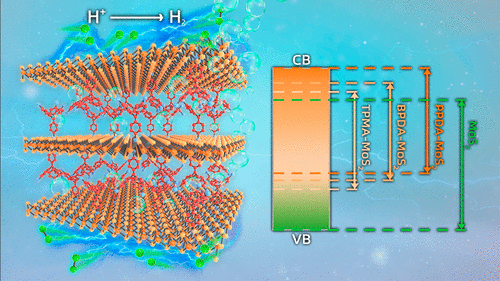当前位置:
X-MOL 学术
›
ACS Sustain. Chem. Eng.
›
论文详情
Our official English website, www.x-mol.net, welcomes your
feedback! (Note: you will need to create a separate account there.)
Reticulation of 2D Semiconductors by Metal–Organic Approach for Efficient Hydrogen Evolution
ACS Sustainable Chemistry & Engineering ( IF 7.1 ) Pub Date : 2020-05-28 , DOI: 10.1021/acssuschemeng.0c02805 Hongmei Dai 1 , Jiao Sun 2 , Yi Zhou 1 , Zirui Zhou 1 , Wei Luo 1 , Guangfeng Wei 2 , Hexiang Deng 1
ACS Sustainable Chemistry & Engineering ( IF 7.1 ) Pub Date : 2020-05-28 , DOI: 10.1021/acssuschemeng.0c02805 Hongmei Dai 1 , Jiao Sun 2 , Yi Zhou 1 , Zirui Zhou 1 , Wei Luo 1 , Guangfeng Wei 2 , Hexiang Deng 1
Affiliation

|
We report a universal approach to synthesize a series of three-dimensional (3D) metal–organic constructs by linking 2D metal dichalcogenides with organic amine molecules [p-phenylenediamine (PPDA), biphenyl diamine (BPDA), tetra(4-aminophenyl) methane) (TPMA)]. Accurate interlayer distances, ranging from 0.61 to 1.7 nm, are dialed-in by the organic components in 3D constructs of MoS2, MoSe2, and WS2. This allows for the exploitation of space between inorganic layers and internal active sites, as reflected in the reduction of band gap, from 2.05 eV in pristine MoS2 to 0.85 eV in a TPMA-MoS2 construct, and an increase in electrical conductivity by 3 × 103 times. Density functional theory calculation further confirms that the promotions in physical properties originate in the formation of 3D constructs. Electrodes based on TPMA-MoS2 offer an overpotential of 103.1 mV at 10 mA cm–2 in hydrogen evolution reactions, standing as the best molecule-based electrodes, with negligible decay in performance during a 12,000-cycle test.
中文翻译:

通过金属-有机方法实现二维半导体的网状结构,以有效地释放氢气
我们报告了一种通用方法,可通过将2D金属二卤化物与有机胺分子[对苯二胺(PPDA),联苯二胺(BPDA),四(4-氨基苯基)甲烷”连接来合成一系列三维(3D)金属-有机结构)(TPMA)]。MoS 2,MoSe 2和WS 2的3D构造中的有机成分可以准确地输入介于0.61到1.7 nm之间的层间距离。这允许利用无机层和内部活性位之间的空间,这从带隙的减小反映出来,从原始MoS 2的2.05 eV到TPMA-MoS 2构造的0.85 eV,电导率提高了3 ×10 3次。密度泛函理论计算进一步证实,物理性能的提升源自3D结构的形成。基于TPMA-MoS 2的电极在10 mA cm –2的析氢反应中提供103.1 mV的过电势,是基于分子的最佳电极,在12,000个循环的测试中性能可忽略不计。
更新日期:2020-05-28
中文翻译:

通过金属-有机方法实现二维半导体的网状结构,以有效地释放氢气
我们报告了一种通用方法,可通过将2D金属二卤化物与有机胺分子[对苯二胺(PPDA),联苯二胺(BPDA),四(4-氨基苯基)甲烷”连接来合成一系列三维(3D)金属-有机结构)(TPMA)]。MoS 2,MoSe 2和WS 2的3D构造中的有机成分可以准确地输入介于0.61到1.7 nm之间的层间距离。这允许利用无机层和内部活性位之间的空间,这从带隙的减小反映出来,从原始MoS 2的2.05 eV到TPMA-MoS 2构造的0.85 eV,电导率提高了3 ×10 3次。密度泛函理论计算进一步证实,物理性能的提升源自3D结构的形成。基于TPMA-MoS 2的电极在10 mA cm –2的析氢反应中提供103.1 mV的过电势,是基于分子的最佳电极,在12,000个循环的测试中性能可忽略不计。











































 京公网安备 11010802027423号
京公网安备 11010802027423号